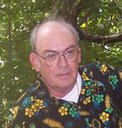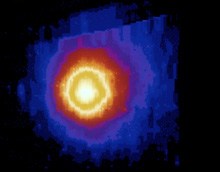Even if the motivating force was politics, science was done.
Hope we don't forget the folks that made it happen.
- LRK -
-----------------------
On the 40th Anniversary of Apollo 17
Forty years after the last human visitors departed the Moon aboard Apollo 17, space historian Andrew Chaikin talks about why we should return.
Hardly a day goes by when I don't think about the Apollo missions to the Moon, voyages that collectively have been called “mankind’s greatest adventure.” Today, 40 years after Apollo 17’s Gene Cernan and Jack Schmitt left the last human footprints in lunar dust, I’m feeling a familiar sense of wistful nostalgia. I miss the Apollo adventure the way I miss my childhood.
Hardly a day goes by when I don't think about the Apollo missions to the Moon, voyages that collectively have been called “mankind’s greatest adventure.” Today, 40 years after Apollo 17’s Gene Cernan and Jack Schmitt left the last human footprints in lunar dust, I’m feeling a familiar sense of wistful nostalgia. I miss the Apollo adventure the way I miss my childhood.
snip
Andrew Chaikin is an award-winning science journalist, space historian, speaker, and author. Chaikin is best known as the author of A Man on the Moon: The Voyages of the Apollo Astronauts, widely regarded as the definitive account of the Moon missions. For more videos, visit Chaikin's YouTube channel.
-----------------------
Lunar and Planetary Institute links.
- LRK -
-----------------------
Science Experiments
Left: The Apollo 17 Scientific Instrument Module (SIM). Right: The instrument layout within the SIM bay.
In addition to their studies on the lunar surface, the Apollo 17 crew performed intensive studies of the Moon from lunar orbit. In addition to photography performed with handheld cameras in the Command Module, a series of experiments were carried in the Scientific Instrument Module on the Service Module.
The Metric and Panoramic cameras provided systematic photography of the lunar surface.
The Laser Altimeter measured the heights of lunar surface features
The S-Band Transponder Experiment measured regional variations in the Moon's gravitational acceleration.
The Apollo Lunar Sounder Experiment used radar to study the structure of the upper kilometer of the lunar crust.
The Ultraviolet Spectrometer Experiment studied the composition of the lunar atmosphere.
The Infrared Radiometer measured the cooling of the Moon's surface at night as a way to determine the physical properties of the lunar soil.
snip
-----------------------
Scientific American, July 1, 2010, article about new findings.
- LRK -
-----------------------
Getting the Lead out: New Look atApollo 17 Moon Sample Reveals Graphite Delivered by a Lunar Impactor
Nearly 40 years after the last manned moon mission, NASA's Apollo program is still producing new findings
By John Matson
Humans have not set foot on the moon since December 14, 1972, when astronauts Eugene Cernan and Harrison Schmitt of the Apollo 17 mission departed the lunar surface to return home. Thankfully, Cernan and Schmitt, a trained geologist, collected 110 kilograms of lunar material—the largest-ever haul of moon rocks and soil—before heading for Earth.
That material is still yielding new insights into the moon's history, as evidenced by a paper in the July 2 issue of Science claiming the first solid evidence for graphite, the form of carbon commonly used as pencil lead, in a lunar sample.
That material is still yielding new insights into the moon's history, as evidenced by a paper in the July 2 issue of Science claiming the first solid evidence for graphite, the form of carbon commonly used as pencil lead, in a lunar sample.
snip
-----------------------
YouTube clip of Apollo 17. About 10 minutes.
- LRK -
-----------------------
Apollo 17 Lunar Rover and Geological Findings.mp4
Uploaded on Mar 14, 2011
Apollo 17 was the 11th manned space mission in the NASA Apollo program. Launched at 12:33 a.m. EST on December 7, 1972, with a crew of Commander Eugene Cernan, Command Module Pilot Ronald Evans, and Lunar Module Pilot Harrison Schmitt, Apollo 17 remains the most recent manned Moon landing and the most recent manned flight beyond low Earth orbit.
Apollo 17 was the sixth and final lunar landing mission of the Apollo program and was the first night launch of a U.S. human spaceflight.
Apollo 17 was the sixth and final lunar landing mission of the Apollo program and was the first night launch of a U.S. human spaceflight.
snip
-----------------------
Images at ALSJ.
- LRK -
-----------------------
Apollo 17 Image Library
Figure Captions Copyright © 1995 by Eric M. Jones.
All rights reserved.
HTML Design by Brian Lawrence.
Last revised 10 October 2012.
snip
This Apollo 17 Image Library contains all of the pictures taken on the lunar surface by the astronauts together with pictures from pre-flight training and pictures of equipment and the flight hardware. High-resolution version of many of the lunar surface images are included. A source for both thumbnail and low -resolution versions of the lunar surface images is a website compiled by Paul Spudis and colleagues at the Lunar and Planetary Institute in Houston.
snip
-----------------------
Harrison H. Schmitt's website.
- LRK -
-----------------------
http://americasuncommonsense.
Harrison Hagan Schmitt, a native of Silver City, NM, has the diverse experience of a geologist, pilot, astronaut, administrator, businessman, writer, and U. S. Senator. Schmitt received his B. S. from Caltech, studied as a Fulbright Scholar at Oslo, and attended graduate school at Harvard. Geological field studies in Norway formed the basis of his Ph.D. in 1964. As a civilian, Schmitt received Air Force jet pilot wings in 1965 and Navy helicopter wings in 1967, logging more than 2100 hours of flying time. Selected for the Scientist-Astronaut program in 1965, Schmitt organized the lunar science training for the Apollo Astronauts, represented the crews during the development of hardware and procedures for lunar surface exploration, and oversaw the final preparation of the Apollo 11 Lunar Module Descent Stage. He served as Mission Scientist in support of the Apollo 11 mission. After training as back-up Lunar Module Pilot for Apollo 15, Schmitt flew in space as Lunar Module Pilot for Apollo 17 – the last Apollo mission to the moon. On December 11, 1972, he landed in the Valley of Taurus-Littrow as the only scientist and the last of 12 men to step on the Moon.
Harrison Hagan Schmitt, a native of Silver City, NM, has the diverse experience of a geologist, pilot, astronaut, administrator, businessman, writer, and U. S. Senator. Schmitt received his B. S. from Caltech, studied as a Fulbright Scholar at Oslo, and attended graduate school at Harvard. Geological field studies in Norway formed the basis of his Ph.D. in 1964. As a civilian, Schmitt received Air Force jet pilot wings in 1965 and Navy helicopter wings in 1967, logging more than 2100 hours of flying time. Selected for the Scientist-Astronaut program in 1965, Schmitt organized the lunar science training for the Apollo Astronauts, represented the crews during the development of hardware and procedures for lunar surface exploration, and oversaw the final preparation of the Apollo 11 Lunar Module Descent Stage. He served as Mission Scientist in support of the Apollo 11 mission. After training as back-up Lunar Module Pilot for Apollo 15, Schmitt flew in space as Lunar Module Pilot for Apollo 17 – the last Apollo mission to the moon. On December 11, 1972, he landed in the Valley of Taurus-Littrow as the only scientist and the last of 12 men to step on the Moon.
snip
-----------------------
Thanks for looking with me.
- LRK -
- LRK -
Web Site: http://lkellogg.vttoth.
BlogSpot: http://
WordPress: http://lrkellogg.
RSS link: http://
Newsletter: https://mailman1.
==============================
THE APOLLO PROGRAM
Apollo 17 Facts
Lunar Module:ChallengerCommand and Service Module:America
Crew:Eugene A. Cernan, commander,
Ronald E. Evans, command module pilot
Harrison H. Schmitt, lunar module pilot
Launch:December 7, 1972
05:33:00 UT (12:33:00 a.m. EST)
Kennedy Space Center Launch Complex 39A
Landing Site:Taurus-Littrow
(20.18N, 30.76E)
Landed on Moon:
December 11, 1972
19:54:57 UT (02:54:57 p.m. EST)
EVA duration:22 hours 4 minutes
( EVA 1: 7 hr 12 min, EVA 2: 7 hr 37 min., EVA 3 ended at 05:40:56 GMT on December 14.)
Lunar Surface Traversed 30 kilometers
Moon Rocks Returned:110 kilograms
LM Departed Moon:
December 14, 1972
22:54:37 UT (5:54:37 p.m. EST)
Time on Lunar Surface:
74 hr. 59 min. 40 sec.
[19:54:57 UT December 11, 1972 - 22:54:37 GMT December 14, 1972]
Returned to Earth:December 19, 1972
splashdown at 19:24:59 UT (2:24:59p.m. EST)
Mission Duration:301 hr. 51 min. 59 sec.
Retrieval site:Pacific Ocean 17° 53' S, 166° 7' W
Retrieval ship:U.S.S. Ticonderoga
snip
==============================
APOLLO 17
LUNAR SURFACE JOURNAL
Corrected Transcript and Commentary Copyright © 1995 by Eric M. Jones.
All rights reserved.
Last revised 9 July 2012.
snip
==============================
WHAT THE MIND CAN CONCEIVE, AND BELIEVE, IT WILL ACHIEVE - LRK -
==============================
==============================






